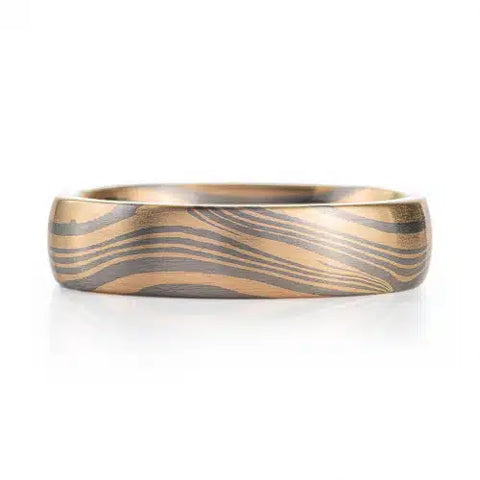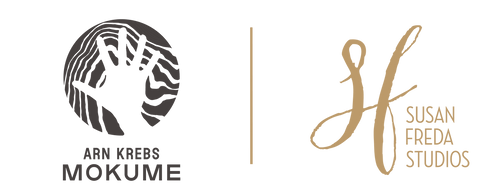News
Use this section to provide a description of your blog.
Mokume Gane vs Damascus
Posted by on
We love to find out how our customers came across Arn’s work, and how they were introduced to mokume gane, and often the answer is that they found mokume through an interest in damascus steel pieces!


The clients who find us through damascus ask what the difference between it and mokume gane are, and the main difference is the materials. Damascus is made with steel, while mokume gane is typically either combinations of base metals (copper, brass, nickel) or precious metals (golds, palladium, platinum, silver). The techniques used to make the billets are similar, and there’s also some cross over in patterning methods.
Another big difference in the visuals of the craft is the color palette. Damascus is primarily what we think of as black and white, while Mokume allows for a range of colors because it can employ gold and other precious metals in all its colors. This also accounts for some of the difference in cost between Damascus and mokume.
Arn particularly likes playing with pattern welding, a technique often seen in damascus pieces. While popular traditional mokume patterns (what we call Twist and Woodgrain) have a more organic, flowing look to them, pattern welding has a repeating style. These patterns still have a beautiful handmade touch, but are visibly more regulated, some even resembling decorative tile! They’re also typically forged style patterns, in which pattern is created in the assembly and stacking of the metals while they’re being forged together, while a lot of mokume gane patterns are made with twisting and carving of the stock.
Some of Arn’s pattern welded work:


And then Arn loves to take this pattern welding concept and push it towards more free flowing forms, finding ways to push and pull the patterned pieces and create something more naturalistic, but still with a satisfying repetition of shapes. This can be seen in Arn’s recent Feather pattern ring, which was created with these damascus style techniques, applied in precious metals using our Firestorm palette (red gold, yellow gold, palladium and silver).

Arn’s work is unique in that he is pushing the boundaries between these art forms and exploring new ground with pattern in mokume gane. Pioneering within this craft is both incredibly time consuming and technically challenging but the results are worth the effort.
Read more
Mokume Gane vs Damascus
Posted by Susan Freda on
We love to find out how our customers came across Arn’s work, and how they were introduced to mokume gane, and often the answer is that they found mokume through an interest in damascus steel pieces!


The clients who find us through damascus ask what the difference between it and mokume gane are, and the main difference is the materials. Damascus is made with steel, while mokume gane is typically either combinations of base metals (copper, brass, nickel) or precious metals (golds, palladium, platinum, silver). The techniques used to make the billets are similar, and there’s also some cross over in patterning methods.
Another big difference in the visuals of the craft is the color palette. Damascus is primarily what we think of as black and white, while Mokume allows for a range of colors because it can employ gold and other precious metals in all its colors. This also accounts for some of the difference in cost between Damascus and mokume.
Arn particularly likes playing with pattern welding, a technique often seen in damascus pieces. While popular traditional mokume patterns (what we call Twist and Woodgrain) have a more organic, flowing look to them, pattern welding has a repeating style. These patterns still have a beautiful handmade touch, but are visibly more regulated, some even resembling decorative tile! They’re also typically forged style patterns, in which pattern is created in the assembly and stacking of the metals while they’re being forged together, while a lot of mokume gane patterns are made with twisting and carving of the stock.
Some of Arn’s pattern welded work:


And then Arn loves to take this pattern welding concept and push it towards more free flowing forms, finding ways to push and pull the patterned pieces and create something more naturalistic, but still with a satisfying repetition of shapes. This can be seen in Arn’s recent Feather pattern ring, which was created with these damascus style techniques, applied in precious metals using our Firestorm palette (red gold, yellow gold, palladium and silver).

Arn’s work is unique in that he is pushing the boundaries between these art forms and exploring new ground with pattern in mokume gane. Pioneering within this craft is both incredibly time consuming and technically challenging but the results are worth the effort.
Read more
Arn's Latest Metal Patterning in Mokume/
Posted by Susan Freda on
When we think of a "traditional" engagement/wedding style, the prong setting easily comes to mind. While this is indeed a classic look, there are some downsides to a prong setting. One thing to keep in mind is that they tend to be higher profile and more vulnerable, making it more likely to get snagged or bumped. Prongs can also weaken over time, and usually require re-tipping to keep a stone secure. Considering this, we'd like to show you a few more hardy and unique (but still elegant) bezel setting styles that can be made to last just like the mokume itself!
A great option for larger and uniquely shaped stones is a bezel setting! Here we have a few different takes on that style that complement the aesthetic of the mokume while also providing protection and support for these stones.
This is a partial mokume bezel, it can also be done as a full bezel, surrounding the stone on all sides. It is created from a piece of mokume stock just like the main ring, and helps the setting feel like an extension of the band with the continuation of mokume patterning!



Read more
Arn's Latest Metal Patterning in Mokume/
Posted by Susan Freda on
When we think of a "traditional" engagement/wedding style, the prong setting easily comes to mind. While this is indeed a classic look, there are some downsides to a prong setting. One thing to keep in mind is that they tend to be higher profile and more vulnerable, making it more likely to get snagged or bumped. Prongs can also weaken over time, and usually require re-tipping to keep a stone secure. Considering this, we'd like to show you a few more hardy and unique (but still elegant) bezel setting styles that can be made to last just like the mokume itself!
A great option for larger and uniquely shaped stones is a bezel setting! Here we have a few different takes on that style that complement the aesthetic of the mokume while also providing protection and support for these stones.
This is a partial mokume bezel, it can also be done as a full bezel, surrounding the stone on all sides. It is created from a piece of mokume stock just like the main ring, and helps the setting feel like an extension of the band with the continuation of mokume patterning!



Read more
Your Custom Mokume Tri Color Ring & The Beauty of Nature
Posted by Susan Freda on
Mokume is a beautiful craft dating back to 17th century Japan for use in sword-making, characterized by a woodgrain like appearance of many layers of different metals fused together to make one piece. This specialized technique of successfully forging together sheets of metal into one billet so that they are bonded and structurally sound requires great skill and years of experience as a metalsmith.
And with this method of creating and patterning rings by hand, either through forging or carving, there is an inherent variability to how the appearance of the ring will ultimately turn out! One of the things Arn loves about mokume and the practice of making it is that not all aspects of how the final ring will look is controllable, which makes each one truly unique. We know that you love this aspect of mokume as well. Nature never makes the same thing twice and this is one of the most striking and under-recognized aspects of what we attribute beauty to. Much like life, handmade things are unpredictable and beautiful.
When you order your ring with us there a few paths to consider. We can help you unravel the work of choosing by walking you through the process a bit here. We offer Custom and Bespoke options.


Firestorm in particular of all of our billets has a range of variation that can be more noticeable and less controllable, as it is a four color combination, rather than two or three. As in its name, this palette is meant to be a whirlwind of color all mixed together to echo the complex and mesmerizing varieties of nature.
Custom vs. Bespoke
Our bespoke options are studio-approved alterations to existing AKM designs. For example you love the pattern but would like a different stock pallet that we offer ; while custom orders are designed from the ground up! This requires much more communication time as well as time at the bench, than a bespoke alteration.



We wish you all a happy holiday season and a bright new year, and look forward to continuing to create with you!
Much love,
Arn Krebs Mokume
Read more
Your Custom Mokume Tri Color Ring & The Beauty of Nature
Posted by Susan Freda on
Mokume is a beautiful craft dating back to 17th century Japan for use in sword-making, characterized by a woodgrain like appearance of many layers of different metals fused together to make one piece. This specialized technique of successfully forging together sheets of metal into one billet so that they are bonded and structurally sound requires great skill and years of experience as a metalsmith.
And with this method of creating and patterning rings by hand, either through forging or carving, there is an inherent variability to how the appearance of the ring will ultimately turn out! One of the things Arn loves about mokume and the practice of making it is that not all aspects of how the final ring will look is controllable, which makes each one truly unique. We know that you love this aspect of mokume as well. Nature never makes the same thing twice and this is one of the most striking and under-recognized aspects of what we attribute beauty to. Much like life, handmade things are unpredictable and beautiful.
When you order your ring with us there a few paths to consider. We can help you unravel the work of choosing by walking you through the process a bit here. We offer Custom and Bespoke options.


Firestorm in particular of all of our billets has a range of variation that can be more noticeable and less controllable, as it is a four color combination, rather than two or three. As in its name, this palette is meant to be a whirlwind of color all mixed together to echo the complex and mesmerizing varieties of nature.
Custom vs. Bespoke
Our bespoke options are studio-approved alterations to existing AKM designs. For example you love the pattern but would like a different stock pallet that we offer ; while custom orders are designed from the ground up! This requires much more communication time as well as time at the bench, than a bespoke alteration.



We wish you all a happy holiday season and a bright new year, and look forward to continuing to create with you!
Much love,
Arn Krebs Mokume
Read more
Mokume Metals By Palette
Posted by Susan Freda on




Read more
Mokume Metals By Palette
Posted by Susan Freda on




Read more
Custom Mokume Gane Pattern Ring Process!
Posted by Susan Freda on







Read more
Custom Mokume Gane Pattern Ring Process!
Posted by Susan Freda on








